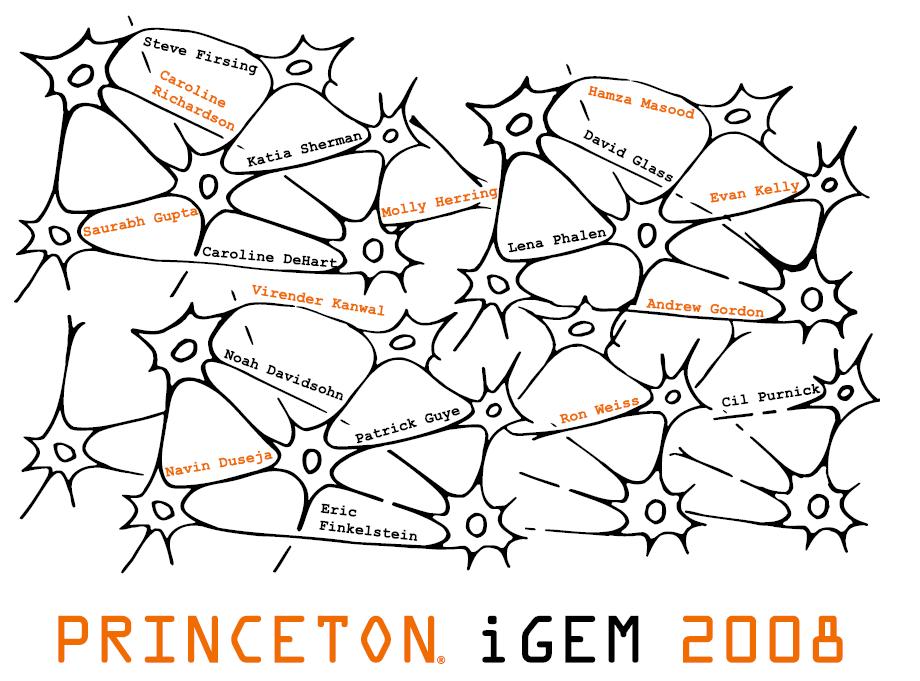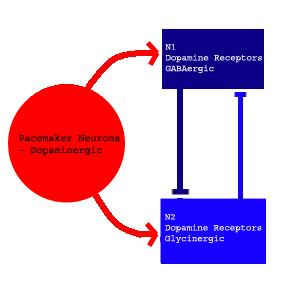Team:Princeton/Project Overview
From 2008.igem.org
PRINCETON IGEM 2008
| Home | Project Overview | Project Details | Experiments | Results | Notebook |
|---|
| Parts Submitted to the Registry | Modeling | The Team | Gallery |
|---|
Why Neurons?

|
Neurotransmitters are distinct among cell-cell communication molecules, which makes the neurons that use them unique research subjects. Neurotransmitters are chemical compounds which relay messages between neurons and other cells through the stimulation of action potentials. They are released in vesicles formed on one side of a synaptic cleft and are received by receptors of neighboring cells. Once the neurotransmitter activates the receptor on the post-synaptic cell, an action potential based on chemical and electrical gradients is triggered and propogates through the axon to the cell body and the dendrites. When the action potential reaches the cell body and the dendrites of the receiving neuron, the same neurotransmitter is usually released and the electrical message is carried further along the pathway of neurons. This method of communication is incredibly fast (milliseconds) relative to transcriptional transfer of information (which usually takes hours), which allows us to see results of our work faster than usual experiments of this nature.
Working with neurotransmitters gives us the advantage of controlling both the inhibitory and excitatory mechanisms of neurons. The actual effect of being an excitatory or inhibitory neuron comes from the receptors present on both the pre- and post-synaptic cells. Certain neurotransmitters increase the probability that an action potential will stimulate the cell while others have an inhibitory effect on the cell by preventing such excitatory behavior. Common inhibitory neurotransmitters include gamma-aminobutyric acid (GABA) and glycine, while a common excitatory neurotransmitter is glutamate. Other neurotransmitters such as dopamine and acetylcholine have the potential to affect cells either way, depending on the post-synaptic cell conditions and available receptors.
Furthermore, neurons are useful in modeling and studying nerve damage, neurodegeneration and other disorders of the nervous system, including Alzheimer's and Parkinson's Diseases. Learning about the function and interaction of neurons can help to create extensive models of these unfortunate disorders and useful tools in eventually finding cures for them.
Description
The goal of the Princeton iGEM team is to utilize the considerable capabilities of neurons and in particular of neuronal networks – in terms of speed of transmission of information, physical and programmable versatility – by designing neural networks using gene-regulatory circuits and microfabrication of surfaces.
Gardner et al. showed in 2003 the construction of a toggle switch using gene-regulatory circuits. Our project is to design a similar toggle switch with neurons. Highly differentiated neurons can be made to produce and/or respond to specific neurotransmitters; and have receptors for these neurotransmitters also. The genetic regulation determines what kinds of neurons embryonic stem cells differentiate into.
The toggle switch is constructed as follows: a cluster of pacemaker neurons constantly excites two clusters of neurons that are designed to cross-repress each other. With an external inhibitory input, either of these neural clusters can be repressed, immediately following which it ceases to repress the other cluster of neurons. This in turn represses the first cluster of neurons, which remains repressed even if the external repression is taken away. Thus, it can be held in a steady state.
Since different neurotransmitters can be excitatory or inhibitory depending on the receptors, we have chosen to build our toggle switch with different 'connections' made with different neurotransmitters. The schematic on the left shows what the neurotransmitter connections look like.
However, the toggle switch also needs to be physically laid out in such a manner as to ensure the connections needed. It has been shown that plating neurons in a specific pattern gives the emerging networks special properties determined by those patterns. Also, the directional growth of these networks is strongly influenced. Therefore, by patterning the surfaces that neurons grow on, we can direct specific network connections. This is at the heart of the architecture of the toggle switch. Since neurons grown in triangles on a microfabricated gold surface pass signals unidirectionally like diodes, they can be used to physically implement the toggle switch network described above. An image, taken from L-Edit (used to design the mask for such gold patterns) shows what the toggle switch should eventually 'look' like.
 "
"


